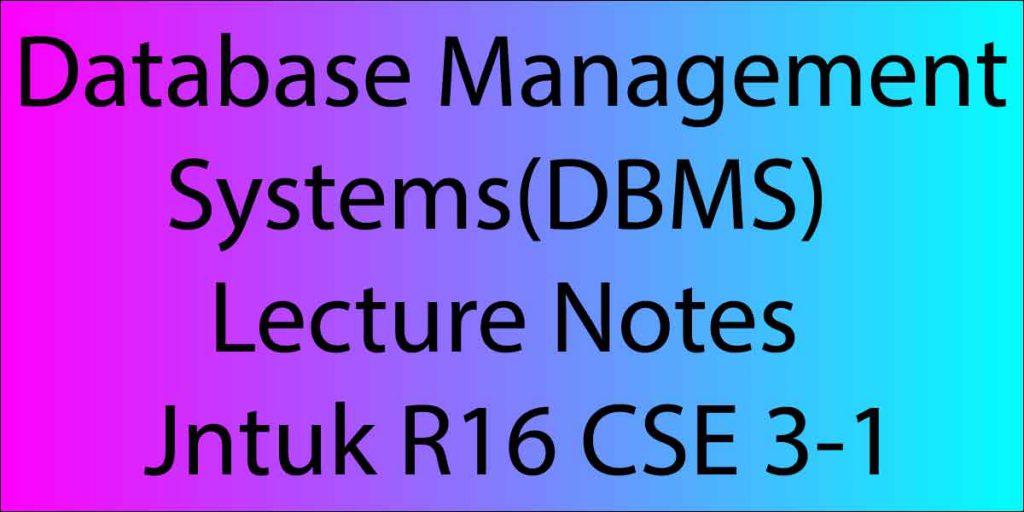Database Management Systems
OBJECTIVES
• to find out the principles of consistently planning and mistreatment massive scale info
Management Systems for varied applications.
UNIT-I:
an summary of management, Introduction- what’s info System- what’s knowledgebase-Why Database- Data Independence- Relation Systems and Others- outline, info system design, Introduction- The 3 Levels of design-The External Level- the abstract Level- the interior Level- Mapping- the info Administrator-The management Systems- Client/Server Architecture.
UNIT-II:
The E/R Models, The relative Model, relative Calculus, Introduction to info style, info style and Er Diagrams-Entities Attributes, and Entity Sets-Relationship and Relationship Sets-Conceptual style With the Er Models, The relative Model Integrity Constraints Over Relations- Key Constraints –Foreign Key Constraints-General Constraints, relative pure mathematics and Calculus, relative Algebra- choice and Projection- Set Operation, Renaming – Joins- Division- a lot of samples of Queries, relative Calculus, Tuple relative Calculus- Domain relative Calculus.
UNIT-III:
Queries, Constraints, Triggers: the shape of Basic SQL question, Union, Intersect, and Except, Nested Queries, combination Operators, Null Values, complicated Integrity Constraints in SQL, Triggers and Active info.
UNIT-IV:
Schema Refinement (Normalization) : Purpose of normalisation or schema refinement, construct of practical dependency, traditional forms supported practical dependency(1NF, 2NF and three NF), construct of surrogate key, Boyce-codd traditional form(BCNF), lossless be a part of and dependency conserving decomposition, Fourth traditional form(4NF).
III Year – I Semester
L T P C
4 0 0 3
UNIT-V:
dealing Management and Concurrency Control:
Transaction, properties of transactions, dealing log, and dealing management with SQL mistreatment commit rollback and save purpose.
Concurrency management for lost updates, uncommitted knowledge, inconsistent retrievals and therefore the hardware. Concurrency management with protection ways : lock graininess, lock types, 2 section protection for making certain serializability, deadlocks, Concurrency management with time stamp ordering : Wait/Die and Wound/Wait Schemes, info Recovery management : dealing recovery.
UNIT-VI:
summary of Storages and assortment, knowledge on External Storage- File Organization and assortment – Clustered assortment – Primary and Secondary Indexes, Index knowledge Structures, Hash-Based assortment – Tree-Based assortment, Comparison of File Organization
OUTCOMES
• Describe a on-line database and electronic database.
• Create, maintain and manipulate a {relational info|electronic database|on-line database|computer database|electronic information service} mistreatment SQL
• Describe ER model and normalisation for database style.
• Examine problems in knowledge storage and question process and might formulate applicable solutions.
• perceive the role and problems in management of knowledge like potency, privacy, security, moral responsibility, and strategic advantage. • style and build info system for a given universe drawback
TEXT BOOKS:
one. Introduction to info Systems, CJ Date, Pearson
2. knowledge base Management Systems, Raghurama Krishnan, Johannes Gehrke, TATA John McGraw Hill third Edition
three. info Systems – the entire Book, H G Molina, J D Ullman, J Widom Pearson
REFERENCES BOOKS:
one. knowledge base Systems style, Implementation, and Management, Peter Rob Coronel seventh Edition.
2. Fundamentals of info Systems, Elmasri Navrate Pearson Education three. Introduction to info Systems, C.J.Date Pearson Education
[content-egg module=Amazon template=list]

